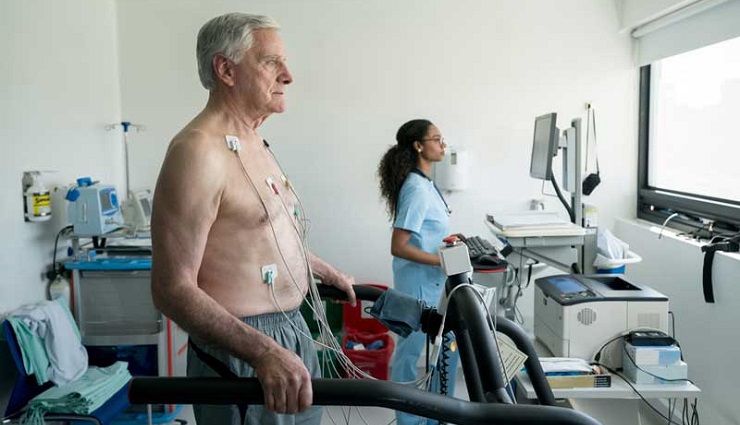An exercise test is a test that determines the reaction of the heart to the most intense activity. To perform this test, a person is usually connected to an electrocardiogram (EKG) machine and walks on a treadmill or pedals on a stationary bike to record the heart’s activity. Various heart diseases are diagnosed with this method, so stay with us to learn more about the procedure, its benefits, and its applications.
What is a cardiac exercise test?
The heart exercise test measures heart rhythm, breathing, blood pressure, and heart rate while walking on a treadmill or riding a stationary bike. Of course, people with arthritis may not be able to do the activities required for the exercise test, and instead, the doctor gives these people drugs that cause more heart activity, like exercise.
Exercise testing is done to answer these questions:
- Does the heart pump blood to the body well?
- Does the heart receive enough blood?
- How is a person’s physical activity compared to his peers and same sex?
- Do you experience chest pain, shortness of breath, rapid heartbeat, or dizziness due to activity?
The answers to these questions make it easier to diagnose some diseases, including:
- heart muscle or valve problems;
- insufficient blood supply to the heart muscle;
- Instability of heart nerve activity during rest and exercise.
The exercise test helps the doctor ensure that his diagnosis or treatment to reduce the risk of heart attack is correct.
How is the exercise test done?
This test initially makes the heart work faster and more robust. For many people, this step includes exercise on a treadmill or stationary bike, and that’s why this test is called an exercise test. The doctor measures the heart’s response to activity by measuring the following:
- blood pressure;
- heartbeat ;
- blood oxygen level;
- electrical activity of the heart;
- Cardiac performance compared to same-sex and age-matched groups.
Types of exercise tests for the heart
Different methods of exercise testing are used depending on the individual’s needs. In the following, we will examine these methods.
1. Exercise stress test
During the exercise test, the doctor tries to measure the heart rate, blood pressure, breathing, and level of fatigue after different amounts of physical activity. The stress test is performed by exercising with a treadmill and has these steps:
- The doctor monitors the heart’s activity by connecting the electrocardiogram electrodes to the person’s chest and checks the result.
- The person stands on the treadmill, and when the treadmill starts moving, the person begins to stroll.
- The speed of the treadmill increases gradually.
- The treadmill may be on an incline.
- Near the end of the test, the person must blow into an orifice to measure their exhaled air.
- The treadmill stops, the person lies down, and the doctor takes their blood pressure and performs other tests.
A person should exercise for 10 to 15 minutes for this test but can stop whenever he feels unwell. The trial is stopped if the person develops these symptoms:
- dizziness;
- high blood pressure ;
- low blood pressure ;
- Arrhythmia or irregular heartbeat;
- Chest pain;
- shortness of breath ;
- Contusion
Also, the doctor will stop the test if he sees any abnormal changes in the ECG.
2. Stress test without exercise
If the person cannot exercise, the doctor can use drugs to produce the effects of exercise in him. In this case, the caregiver attaches the electrodes to the person’s chest and gives the medication through a vein in the arm. Medicines show their effect after 15 to 20 minutes and stimulate the heart. Their products are similar to those during exercise, such as flushing or shortness of breath.
3. Nuclear stress test
This advanced test uses safe levels of radioactive materials and cardiac imaging scans to evaluate heart activity. The cardiologist records images of the heart before and after exercise and compares the blood supply to the heart muscles during rest and after exercise. Decreased blood flow is usually a sign of a blockage in one or more heart arteries. This test can:
- determine the severity of coronary artery blockage;
- measure the performance of previous treatments such as stenting or bypass surgery;
- replace more invasive cardiac tests such as angiography ;
- It shows whether your heart is healthy enough for non-cardiac surgery or exercise.
4. Exercise test for cardiac rehabilitation
The program may include exercise testing if your doctor prescribes cardiac rehabilitation. This rehabilitation is a type of exercise with the medical staff’s supervision that helps people be more physically active despite heart disease. Types of exercise tests for cardiac rehabilitation include:
- Intake exercise testing: Helps the rehabilitation team determine a program that matches the patient’s abilities.
- Exit exercise test: allows the team to measure the patient’s progress and formulate a long-term exercise program after rehabilitation.
Who should take an exercise test?
This test is prescribed if there are symptoms of heart disease, including:
- Angina, which is chest pain caused by a blood supply disorder to the heart;
- Arrhythmia, which means fast and irregular heartbeat;
- shortness of breath (dyspnea);
- feeling dizzy
Also, this test is used for people who have been diagnosed with heart disease and have the following conditions:
- They want to start exercising;
- have received treatment, and the caregiver wants to make sure of its positive effect;
- Due to personal or family history of heart disease, they are more exposed to complications;
- have diabetes or other underlying disorders that increase the risk of heart disease;
- They need non-cardiac surgery, and the doctor wants to assess the risk of surgical complications.
In addition, exercise testing may be done for people without diagnosed or symptomatic heart disease to assess their risk of developing heart disease and heart attack, especially if other underlying factors such as diabetes, high blood pressure, high cholesterol, or a history of heart disease are present. Have a family history of premature heart disease.
What does the exercise test show?

If you are looking for what the exercise test shows, You should know that the possible results of this test are:
- regular blood supply during exercise and rest;
- standard blood supply during rest but not practice, which may be a sign of arterial occlusion;
- low blood flow during rest and training, which is a sign of coronary artery disease;
- Contrast material not reaching some parts, which shows tissue damage.
The doctor asks the patient to exercise at 85% of his maximum heart rate. This number is determined by subtracting the person’s age from 220. If the heart rate exceeds the maximum, the doctor asks the patient to stop exercising.
The doctor may also notice a decrease in heart rate after exercise. To determine its quality, the heart rate is reduced from the maximum heart rate one minute after stopping the practice. If the heart rate drops significantly, it signifies easy recovery.
| Maximum heart rate minus heart rate 1 minute after intense exercise | Function |
| Less than 12 beats per minute after rest with walking | Odd |
| More than 12 beats per minute after rest with walking | normal |
| Less than 18 beats per minute after resting while lying down | Odd |
| More than 18 beats per minute after resting while lying down | normal |
The doctor also monitors the person’s blood pressure. A change in diastolic or systolic blood pressure (minimum and maximum) can indicate some diseases. The doctor measures these changes based on millimeters of mercury.
| Blood pressure results | meaning |
| Blood pressure rises below 10 mm Hg | People taking antihypertensive drugs have a more limited response |
| Diastolic blood pressure should change to less than 10 mm Hg | Peripheral vasodilation |
| Systolic blood pressure should decrease by more than 10 mm Hg | Severe left ventricular dysfunction or severe coronary artery disease |
| Systolic blood pressure more significant than 250 mm Hg or diastolic blood pressure greater than 120 mm Hg. | Very high blood pressure |
The person does not need further tests if the exercise test results are not problematic. The doctor will order more tests if the inconclusive results suggest damage.
Which people should not take an exercise test?
Exercise testing is not suitable for everyone. You may not need an exercise test if you have these conditions:
- Coronary artery disease if you have received successful treatment and have not had any new symptoms for years;
- not having a family history of coronary artery disease or its symptoms;
- A small probability of heart disease, for example, in people who do not smoke, are physically active, and eat healthy foods.
Also, this test is not suitable for people who have certain heart diseases, including:
- Aortic dissection;
- Inflammation of the layers of the heart, such as endocarditis, pericarditis, or myocarditis (inflammation of the heart muscle);
- recent heart attack;
- severe aortic stenosis;
- abnormal, uncontrolled heart rhythm;
- Persistent chest pain.
The cardiologist will measure your overall health for the test, such as:
- Age;
- family history of heart disease;
- gender;
- health history;
- amount of physical activity;
- signs;
- Risk factors include smoking, diabetes, high blood pressure, and high cholesterol.
Risks of exercise testing
Exercise testing and nuclear testing are usually safe. Of course, in rare cases, they can cause complications. These complications include a heart attack or a change in the heart rhythm (which does not go away even after the test). According to statistics, these complications affect 1 out of every 10,000 people. For this reason, the doctor does not prescribe this test for people with heart disease or arthritis or who have recently had a stroke or heart attack.
Exercise test in pregnancy
Usually, the doctor does not prescribe an exercise test for a pregnant person because the risks outweigh the benefits. The reason is that pregnancy puts more pressure on the cardiovascular system. Of course, researchers have performed this test safely until the 38th week of pregnancy. Pregnant people should not do the nuclear stress test because it harms the development of the fetus.
Some pregnancy complications are associated with an increased risk of cardiovascular disease, including:
- Preeclampsia (sensitivity of pregnancy);
- gestational diabetes ;
- high blood pressure;
- Intrauterine growth restriction.
These tests may be used to screen for cardiovascular diseases:
- fitness test;
- Evaluating grip strength (isometric handgrip test);
- Blood pressure increase test with cold (cold pressor test).
One of the benefits of exercise testing during pregnancy is that it determines physical fitness, and doing it in the first trimester helps to predict the risks of continued pregnancy. Its disadvantage is the pressure it puts on a pregnant person. It may be necessary to use a recumbent bike or other special equipment, which makes it difficult to determine the intensity of the exercise.
Actions before the exercise test
- Do not eat anything for a few hours before the test. If you have a nuclear stress test, you may not be able to eat anything until after the trial.
- Do not consume caffeine 24 hours before the test. You should not use coffee, tea, energy drinks, or non-prescription drugs.
- Avoid smoking and tobacco.
- Before the test, consult your doctor about stopping some medications, including beta blockers and asthma sprays.
- Try to be calm. It is normal to have anxiety before heart tests, but it can affect the test results.
- Wear light and comfortable clothes and sturdy walking shoes.
Common questions
1. How is the exercise test performed?
Before the test begins, a technician will measure your vital signs, including your heart rate and resting blood pressure. Small electrocardiogram (EKG) electrodes are attached to your chest. Then you need to walk on a treadmill or ride a stationary bike and gradually increase your speed. Your heart’s response to activity is measured in this test.
2. How long does the exercise test take?
The exercise portion of this test takes 10 to 15 minutes, but more time is needed to prepare and rest afterward. Of course, if severe symptoms appear or you want to stop the test, the technician will finish the test sooner.
3. What diseases is this test used to diagnose?
The doctor uses this test to diagnose congestive heart disease, congestive heart failure, coronary artery disease, heart valve disease, and hypertrophic cardiomyopathy. People in dangerous jobs, such as pilots and professional athletes, may also take this test.
4. Is exercise testing dangerous?
This test is usually safe, but it is prohibited for some people. Few people suffer complications by doing this test. An exercise physiologist and cardiologist are present during the test to help in case of difficulties. These people monitor the patient’s performance and symptoms and provide emergency care if necessary. Of course, the patient can stop this test whenever he is anxious or uncomfortable.
final word
The exercise test is a non-invasive and effective way to detect heart function during exercise and helps to diagnose various diseases. It can also determine how much pressure the heart can withstand. This information is useful when planning surgery or an intense exercise program. Reducing your anxiety by increasing your knowledge about the test and taking it confidently is good because pressure can adversely affect the test result.
Warning! This article is only for educational purposes; to use it, it is necessary to consult a doctor or specialist.



